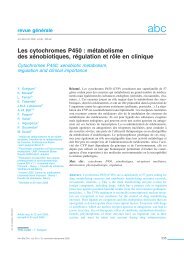Effects and clinical potential of very-low-calorie diets (VLCDs) in ...
Effects and clinical potential of very-low-calorie diets (VLCDs) in ...
Effects and clinical potential of very-low-calorie diets (VLCDs) in ...
You also want an ePaper? Increase the reach of your titles
YUMPU automatically turns print PDFs into web optimized ePapers that Google loves.
DIAB-4541; No <strong>of</strong> Pages 86diabetes research <strong>and</strong> <strong>cl<strong>in</strong>ical</strong> practice xxx (2009) xxx–xxxAmerican Diabetes Association, Diabetes Care 31 (Suppl. 1)(2008) S61–78.[5] J.B. Dixon, P.E. O’Brien, J. Playfair, L. Chapman, L.M.Schachter, S. Sk<strong>in</strong>ner, et al., Adjustable gastric b<strong>and</strong><strong>in</strong>g <strong>and</strong>conventional therapy for type 2 diabetes: a r<strong>and</strong>omizedcontrolled trial, JAMA 299 (2008) 316–323.[6] A.C. Feldste<strong>in</strong>, G.A. Nichols, D.H. Smith, V.J. Stevens, K.Bachman, A.G. Rosales, et al., Weight change <strong>in</strong> diabetes<strong>and</strong> glycemic <strong>and</strong> blood pressure control, Diabetes Care 31(2008) 1960–1965.[7] M.A. Khan, J.V. St Peter, G.A. Breen, G.G. Hartley, J.T.Vessey, Diabetes disease stage predicts weight lossoutcomes with long-term appetite suppressants, Obes. Res.8 (2000) 43–48.[8] A. Astrup, E. Vrist, F. Quaade, Dietary fibre added to <strong>very</strong><strong>low</strong> <strong>calorie</strong> diet reduces hunger <strong>and</strong> alleviates constipation,Int. J. Obes. 14 (1990) 105–112.[9] D. Festi, A. Colecchia, M. Ors<strong>in</strong>i, A. Sangermano, S. Sottili, P.Simoni, et al., Gallbladder motility <strong>and</strong> gallstone formation<strong>in</strong> obese patients fol<strong>low</strong><strong>in</strong>g <strong>very</strong> <strong>low</strong> <strong>calorie</strong> <strong>diets</strong>. Use it(fat) to lose it (well), Int. J. Obes. Relat. Metab. Disord. 22(1998) 592–600.[10] P. Mustajoki, T. Pekkar<strong>in</strong>en, Very <strong>low</strong> energy <strong>diets</strong> <strong>in</strong> thetreatment <strong>of</strong> obesity, Obes. Rev. 2 (2001) 61–72.[11] J.S. Torgerson, L. Agren, L. Sjostrom, <strong>Effects</strong> on body weight<strong>of</strong> strict or liberal adherence to an <strong>in</strong>itial period <strong>of</strong> VLCDtreatment. A r<strong>and</strong>omised, one-year <strong>cl<strong>in</strong>ical</strong> trial <strong>of</strong>obese subjects, Int. J. Obes. Relat. Metab. Disord. 23 (1999)190–197.[12] H.C. Seim, J.E. Mitchell, C. Pomeroy, M. de Zwaan,Electrocardiographic f<strong>in</strong>d<strong>in</strong>gs associated with <strong>very</strong> <strong>low</strong><strong>calorie</strong> diet<strong>in</strong>g, Int. J. Obes. Relat. Metab. Disord. 19 (1995)817–819.[13] J.W. Anderson, C.C. Hamilton, V. Br<strong>in</strong>kman-Kaplan, Benefits<strong>and</strong> risks <strong>of</strong> an <strong>in</strong>tensive <strong>very</strong>-<strong>low</strong>-<strong>calorie</strong> diet program forsevere obesity, Am. J. Gastroenterol. 87 (1992) 6–15.[14] R.R. Henry, T.A. Wiest-Kent, L. Scheaffer, O.G. Kolterman,J.M. Olefsky, Metabolic consequences <strong>of</strong> <strong>very</strong>-<strong>low</strong>-<strong>calorie</strong>diet therapy <strong>in</strong> obese non-<strong>in</strong>sul<strong>in</strong>-dependent diabetic <strong>and</strong>nondiabetic subjects, Diabetes 35 (1986) 155–164.[15] Very <strong>low</strong>-<strong>calorie</strong> <strong>diets</strong>. National Task Force on thePrevention <strong>and</strong> Treatment <strong>of</strong> Obesity, National Institutes <strong>of</strong>Health, JAMA 270 (1993) 967–974.[16] R.E. Andersen, T.A. Wadden, R.J. Herzog, Changes <strong>in</strong> bonem<strong>in</strong>eral content <strong>in</strong> obese diet<strong>in</strong>g women, Metabolism 46(1997) 857–861.[17] E. Delbridge, J. Proietto, State <strong>of</strong> the science: VLED (VeryLow Energy Diet) for obesity, Asia Pac. J. Cl<strong>in</strong>. Nutr. 15(Suppl.) (2006) 49–54.[18] P. Sumithran, J. Proietto, Ketogenic <strong>diets</strong>: a review <strong>of</strong> theirpr<strong>in</strong>ciples, safety <strong>and</strong> efficacy, Obes. Res. Cl<strong>in</strong>. Pract. 2(2008) 1–13.[19] R.L. Jungas, M.L. Halper<strong>in</strong>, J.T. Brosnan, Quantitativeanalysis <strong>of</strong> am<strong>in</strong>o acid oxidation <strong>and</strong> relatedgluconeogenesis <strong>in</strong> humans, Physiol. Rev. 72 (1992) 419–448.[20] G.L. Pawan, S.J. Semple, Effect <strong>of</strong> 3-hydroxybutyrate <strong>in</strong>obese subjects on <strong>very</strong>-<strong>low</strong>-energy <strong>diets</strong> <strong>and</strong> dur<strong>in</strong>gtherapeutic starvation, Lancet 1 (1983) 15–17.[21] F.J. McClernon, W.S. Yancy Jr., J.A. Eberste<strong>in</strong>, R.C. Atk<strong>in</strong>s, E.C.Westman, The effects <strong>of</strong> a <strong>low</strong>-carbohydrate ketogenic diet<strong>and</strong> a <strong>low</strong>-fat diet on mood, hunger, <strong>and</strong> other self-reportedsymptoms, Obesity (Silver Spr<strong>in</strong>g) 15 (2007) 182–187.[22] J.C. Rosen, J. Gross, D. Loew, E.A. Sims, Mood <strong>and</strong> appetitedur<strong>in</strong>g m<strong>in</strong>imal-carbohydrate <strong>and</strong> carbohydratesupplementedhypocaloric <strong>diets</strong>, Am. J. Cl<strong>in</strong>. Nutr. 42 (1985)371–379.[23] J.W. Anderson, E.C. Konz, R.C. Frederich, C.L. Wood, Longtermweight-loss ma<strong>in</strong>tenance: a meta-analysis <strong>of</strong> USstudies, Am. J. Cl<strong>in</strong>. Nutr. 74 (2001) 579–584.[24] T. Pekkar<strong>in</strong>en, P. Mustajoki, Comparison <strong>of</strong> behaviortherapy with <strong>and</strong> without <strong>very</strong>-<strong>low</strong>-energy diet <strong>in</strong> thetreatment <strong>of</strong> morbid obesity. A 5-year outcome, Arch.Intern. Med. 157 (1997) 1581–1585.[25] J.W. Anderson, S. Vichitb<strong>and</strong>ra, W. Qian, R.J. Kryscio, Longtermweight ma<strong>in</strong>tenance after an <strong>in</strong>tensive weight-lossprogram, J. Am. Coll. Nutr. 18 (1999) 620–627.[26] T.A. Wadden, J.A. Sternberg, K.A. Letizia, A.J. Stunkard,G.D. Foster, Treatment <strong>of</strong> obesity by <strong>very</strong> <strong>low</strong> <strong>calorie</strong>diet, behavior therapy, <strong>and</strong> their comb<strong>in</strong>ation: afive-year perspective, Int. J. Obes. 13 (Suppl. 2) (1989)39–46.[27] G. Sik<strong>and</strong>, A. Kondo, J.P. Foreyt, P.H. Jones, A.M. Gotto Jr.,Two-year fol<strong>low</strong>-up <strong>of</strong> patients treated with a <strong>very</strong>-<strong>low</strong><strong>calorie</strong>diet <strong>and</strong> exercise tra<strong>in</strong><strong>in</strong>g, J. Am. Diet Assoc. 88(1988) 487–488.[28] H. Moore, C. Summerbell, L. Hooper, K. Cruickshank, A.Vyas, P. Johnstone, et al., Dietary advice for treatment <strong>of</strong>type 2 diabetes mellitus <strong>in</strong> adults, Cochrane Database Syst.Rev. (2004) CD004097.[29] X.R. Pan, G.W. Li, Y.H. Hu, J.X. Wang, W.Y. Yang, Z.X. An,et al., <strong>Effects</strong> <strong>of</strong> diet <strong>and</strong> exercise <strong>in</strong> prevent<strong>in</strong>g NIDDM<strong>in</strong> people with impaired glucose tolerance. The DaQ<strong>in</strong>g IGT <strong>and</strong> Diabetes Study, Diabetes Care 20 (1997)537–544.[30] J. L<strong>in</strong>dstrom, A. Louheranta, M. Mannel<strong>in</strong>, M. Rastas, V.Salm<strong>in</strong>en, J. Eriksson, et al., The F<strong>in</strong>nish DiabetesPrevention Study (DPS): lifestyle <strong>in</strong>tervention <strong>and</strong> 3-yearresults on diet <strong>and</strong> physical activity, Diabetes Care 26 (2003)3230–3236.[31] W.C. Knowler, E. Barrett-Connor, S.E. Fowler, R.F. Hamman,J.M. Lach<strong>in</strong>, E.A. Walker, et al., Reduction <strong>in</strong> the <strong>in</strong>cidence<strong>of</strong> type 2 diabetes with lifestyle <strong>in</strong>tervention or metform<strong>in</strong>,N. Engl. J. Med. 346 (2002) 393–403.[32] K.G. Alberti, P. Zimmet, J. Shaw, International DiabetesFederation: a consensus on Type 2 diabetes prevention,Diabet. Med. 24 (2007) 451–463.[33] R.R. W<strong>in</strong>g, M.D. Marcus, L.H. Epste<strong>in</strong>, R. Salata, Type IIdiabetic subjects lose less weight than their overweightnondiabetic spouses, Diabetes Care 10 (1987) 563–566.[34] J.C. Guare, R.R. W<strong>in</strong>g, A. Grant, Comparison <strong>of</strong> obeseNIDDM <strong>and</strong> nondiabetic women: short- <strong>and</strong> long-termweight loss, Obes. Res. 3 (1995) 329–335.[35] A. Gokcel, H. Karakose, E.M. Ertorer, N. Tanaci, N.B.Tutuncu, N. Guvener, <strong>Effects</strong> <strong>of</strong> sibutram<strong>in</strong>e <strong>in</strong> obesefemale subjects with type 2 diabetes <strong>and</strong> poor bloodglucose control, Diabetes Care 24 (2001) 1957–1960.[36] A.J. Scheen, N. F<strong>in</strong>er, P. Holl<strong>and</strong>er, M.D. Jensen, L.F. VanGaal, Efficacy <strong>and</strong> tolerability <strong>of</strong> rimonabant <strong>in</strong> overweightor obese patients with type 2 diabetes: a r<strong>and</strong>omisedcontrolled study, Lancet 368 (2006) 1660–1672.[37] G.M. Campos, C. Rabl, K. Mulligan, A. Posselt, S.J. Rogers,A.C. Westphalen, et al., Factors associated with weight lossafter gastric bypass, Arch. Surg. 143 (2008) 877–883,discussion 884.[38] P.A. Dyson, S. Beatty, D.R. Matthews, A <strong>low</strong>-carbohydratediet is more effective <strong>in</strong> reduc<strong>in</strong>g body weight than healthyeat<strong>in</strong>g <strong>in</strong> both diabetic <strong>and</strong> non-diabetic subjects, Diabet.Med. 24 (2007) 1430–1435.[39] M.D. Harris, M.B. Davidson, M.A. Bush, Exogenous <strong>in</strong>sul<strong>in</strong>therapy s<strong>low</strong>s weight loss <strong>in</strong> type 2 diabetic patients, Int. J.Obes. 12 (1988) 149–155.[40] K.G. Alberti, D.G. Johnston, A. Gill, A.J. Barnes, H. Orskov,Hormonal regulation <strong>of</strong> ketone-body metabolism <strong>in</strong> man,Biochem. Soc. Symp. (1978) 163–182.[41] R. Geldszus, B. Mayr, R. Horn, F. Geisthovel, A. vonzur Muhlen, G. Brabant, Serum lept<strong>in</strong> <strong>and</strong> weightreduction <strong>in</strong> female obesity, Eur. J. Endocr<strong>in</strong>ol. 135 (1996)659–662.Please cite this article <strong>in</strong> press as: S. Baker, et al., <strong>Effects</strong> <strong>and</strong> <strong>cl<strong>in</strong>ical</strong> <strong>potential</strong> <strong>of</strong> <strong>very</strong>-<strong>low</strong>-<strong>calorie</strong> <strong>diets</strong> (<strong>VLCDs</strong>) <strong>in</strong> type 2 diabetes,Diab. Res. Cl<strong>in</strong>. Pract. (2009), doi:10.1016/j.diabres.2009.06.002
















